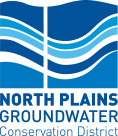200-12 Demonstration Project
200-12 Project
Since beginning as a District-funded demonstration with board members as the only participants in 2010, the “200-12 Project” has received funding from both the Texas Water Development Board and the USDA – Natural Resources Conservation Service and has involved many of the most progressive farmers in the northern Panhandle, including four members of the board of directors. The “200-12 Project” received the NRCS Conservation Innovation Grant as part of the Texas High Plains Initiative for Efficient Irrigation Management and Conservation (Texas High Plains Initiative). The Texas High Plains Initiative was a cooperative effort between the District’s “200-12 Project”, and the Texas Alliance for Water Conservation (TAWC), which includes Texas Tech University, High Plains Underground Water Conservation District and others. With demonstrations spanning the High Plains from north to south, the Texas High Plains Initiative helped expand the reach of the conservation mission throughout the region.
The project has also earned media coverage from local, state and national newspaper, radio and television outlets and received the Texas Water Conservation Advisory Council’s Save Texas Water Blue Legacy Award for agriculture in 2012, and the state’s highest conservation honor, The Texas Environmental Excellence Award for Agriculture, in 2011. Designed as a five-year demonstration, the “200-12 Project” concluded its’ final season in 2014.
From Space Age to Down to Earth
The “200-12 Project” resource management system is a combination of conservation strategies ranging from the tried-and-true to cutting edge. The system is built on techniques and technologies recommended by farmers and other experts, because they work.
Remote Pivot Monitoring and Control
The ability to monitor and control a sprinkler without having to be at the location will allow producers to save precious time and consequently save water when making adjustments to the operation of the sprinkler.
Remote Soil Moisture Monitoring
Electronic soil probes measure the conductivity of the soil, tracking moisture and plant water usage in real time. The information is transmitted via telemetry to farmers’ smartphones and computers, allowing them to make irrigation management adjustments remotely. Giving the plant just what it needs, when it needs it, creates water savings.
Residue Management
Reduced tillage practices like strip-till and no-till enhance infiltration of rainfall and reduce evaporation by shading and cooling the soil. As an added benefit, the remaining residue decomposes adding organic material and building soil structure, which increases water holding and storage capability.
Nutrient Management
Closely managed fertilizer regimens guard against unnecessary stress on the plant either from too much, or not enough, nutrients. Healthy plants are more efficient with the water that’s applied.
Plant Population
Using less water requires farmers to reduce the number of seeds they plant to make sure there is enough water available for each plant to be as successful as possible. Fewer seeds do not necessarily mean lower yields because, though there may be fewer plants and fewer ears of corn, the healthier plants may produce bigger ears, especially if the hybrid has been bred to grow larger ears. This trait is called “ear flex”.
Drought Tolerant Hybrids
Drought tolerant hybrids are hybrids that have been bred to perform better than others when less water is applied. Other traits like increased ear flex can also maintain or increase yields with less water. Seed companies continue to advance the technology and these hybrids are an important part of the strategy of doing more with less.
Planting Dates
Later planting dates are allowing farmers to schedule pollination to avoid the hottest times of the summer, while reducing the number of days the dry seeds are in the ground, if the early growing season is dry. Depending on the seasonal rainfall, later planting dates can have positive impacts on yield, while maximizing available water.
Variable Rate Irrigation
Based on either satellite imagery or electronic soil scans, farmers are able to create maps of the moisture and soil profile of an entire field. Using that profile, combined with programmable center pivot sprinklers, farmers adjust the amount of water that is applied to different parts of the field.
High Efficiency, Low Elevation/Low Energy Precision Application
These sprinkler systems maximize water delivered to the plant by using bubblers attached to long hoses that drizzle the water close to the ground. The short distance to the ground for the water to fall and the bubbling action, instead of spraying, reduce evaporation and increase the efficiency of these systems to 90-95%.
Final Reports for 200-12 Project
200-12 Final Report 2014
200-12 Final Report 2013
200-12 Final Report 2012
200-12 Final Report 2011
200-12 Final Report 2010
